Sleep Review interviews Joseph Goldstein, president of Stevenson Industries Inc and inventor of the CPAP PRO®

When Joseph Goldstein invented the CPAP PRO® nasal interface, he didn’t just think he knew what continuous positive airway pressure (CPAP) users wanted in a mask, he knew from personal experience. After being diagnosed with sleep apnea in 1996 and finding traditional masks unbearable, Goldstein set out to work on an alternative. Sleep Review spoke with Goldstein, president of Stevenson Industries Inc, Pacific Palisades, Calif, about his invention.
Q. As a CPAP user, what was the biggest hindrance to your compliance?
A. I was able to use CPAP for about a week or two, and then the pain around the nose and the leakage into the eyes just became intolerable to the extent that I started to put Xylocaine around my nose, take an Advil at night, and try to fall asleep before the pain got bad. Eventually, after trying every mask that was made and every brand-new mask that was supposed to be the best of all masks, I finally quit using CPAP. Then it dawned on me one morning that there was only one part of the body that stayed in direct relationship with the nose, and that’s the upper teeth. Therefore, I invented CPAP PRO, which is a device using a mouthpiece that snaps onto a patient’s teeth. The mouthpiece has a thin plastic bracket extending between the patient’s lips that holds the parallel tubes that convey the CPAP air to the nostrils. Since the upper teeth are always in direct relationship with the nose, as patients sleep they can twist and turn and move around and all the components of the CPAP PRO remain exactly in place with the nostrils.
Q. Why did you decide to market CPAP PRO directly to patients instead of through durable medical equipment (DME) dealerships?
A. After spending thousands of dollars and a great deal of time, we determined that conventional DME providers and respiratory therapists are under tremendous time constraints. What they do is simply fit patients with the conventional masks, make several adjustments, and send the patients on their way. They really don’t want to fiddle too long with patients and attempt to make a “boil ’n bite” mouthpiece.
Our greatest success has been through our Internet site and telephone inquiries whereby we sell the product directly to the patient. There are excellent instructions and it takes about 15 minutes to prepare the device at home and make the adjustments.
Q. How do patients make the boil ’n bite mouthpiece?
A. They immerse the mouthpiece in water in a sauce pan, bring the water to a rapid boil, let the mouthpiece cool to a safe temperature (a safety thermometer is included with the CPAP PRO), put it in their mouth, and press it hard against their upper teeth. The filler material solidifies, and from that point on, the mouthpiece snaps onto the patient’s upper teeth and stays in place throughout the night all by itself. There’s no need for the patient to continually bite down on it.
Q. How are the actual compliance results?
A. Our main patient base is those who have tried all the other interfaces, have been disillusioned, and are ready to give up or have given up on it and are looking for a solution. Every day I get phone calls from patients all over the country telling me how this has changed their life.





